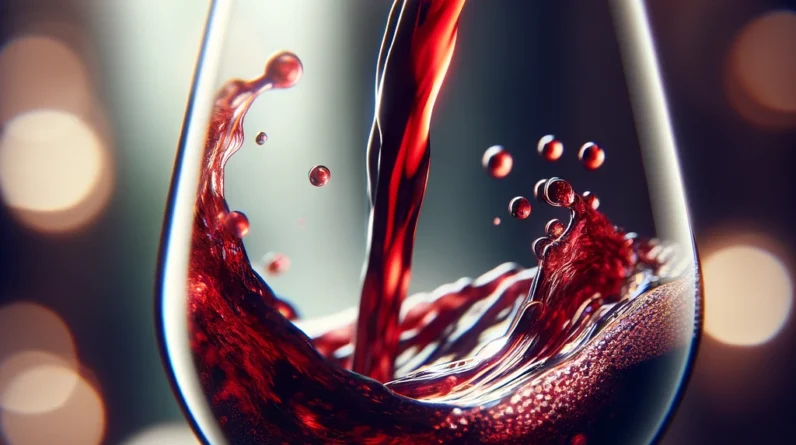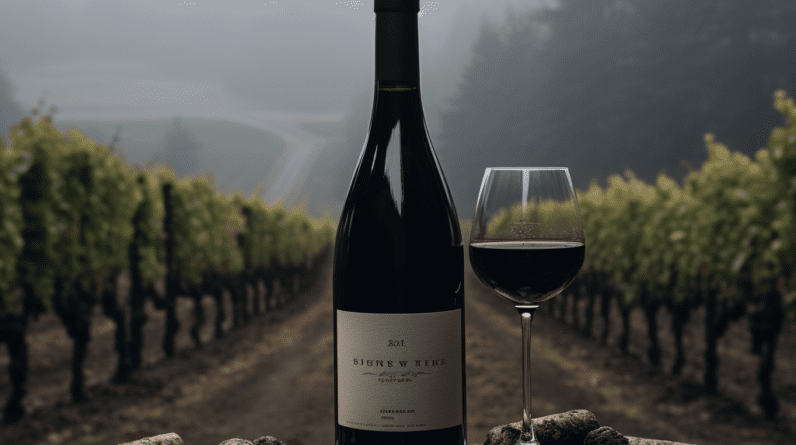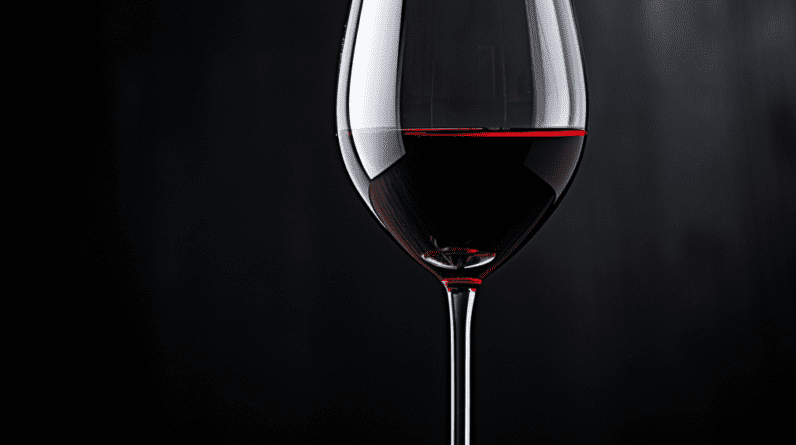
Exploring the World of Dry Red Wines: A Beginner’s Guide
Welcome to the vibrant world of red wines!
If you’ve ever been curious about what makes a red wine ‘dry,’ you’re in the right place.
This article will unravel the mystery behind dry red wines, making it easy and enjoyable for beginners and enthusiasts alike.
What Makes a Red Wine ‘Dry’?
The term ‘dry’ in wine terminology refers to the absence of residual sugar, meaning the wine is not sweet.
During fermentation, yeast converts the sugar in grapes into alcohol.
In dry wines, this process continues until almost all the sugar is consumed, leaving less than 1% residual sugar.
As a result, dry red wines have a more subtle sweetness, if any, and are characterized by their crisp and tannic nature.
Characteristics of Dry Red Wines
Dry red wines are known for their complex flavors and aromas.
These wines often have notes of dark fruits like blackberries, cherries, and plums, along with hints of spices, earth, and sometimes oak.
They are also recognized for their tannins, which give the wine structure and can contribute to a dry mouthfeel.
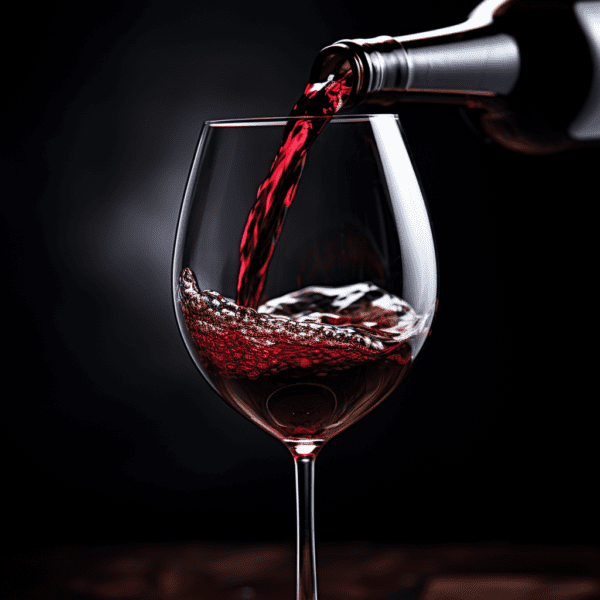
Popular Varieties of Dry Red Wine
Some well-known dry red wines include.
Cabernet Sauvignon
Famous for its bold flavors and high tannins.
Cabernet Sauvignon is often regarded as the “king” of red wines, known for its deep color, full body, and an alcohol content that’s on the higher side.
Its flavors are robust, with notes of blackcurrant, black cherry, and other dark fruits, often complemented by hints of cedar, tobacco, and oak.
The tannins are pronounced, contributing to its notable structure and aging potential.
Beginner Recommendations
If you’re new to Cabernet Sauvignon, look for bottles from California, particularly Napa Valley, or Chile.
These regions produce wines that are not only high quality but also relatively approachable for beginners.
Start with a younger vintage, as these will be less tannic and easier on the palate.
Robert Mondavi Napa Valley Cabernet Sauvignon: A classic example from Napa Valley, known for its rich flavors of blackberry, cassis, and oak.
Chateau Ste. Michelle Cabernet Sauvignon: From Washington State, offering a more approachable style with balanced fruit and tannin.
Merlot
Softer than Cabernet, with plummy flavors and a smooth finish.
Merlot is a versatile and approachable wine, often softer and fruitier than Cabernet Sauvignon.
It typically features flavors of plum, black cherry, and herbal notes, with a smoother and less tannic mouthfeel.
Merlot is medium-bodied and can range from dry to slightly sweet, making it an excellent choice for those who are new to red wines.
Beginner Recommendations
For a first-time Merlot drinker, wines from California or Washington State are great starting points.
These regions produce Merlots that are fruit-forward and less complex, which can be more palatable for beginners.
A Merlot with a few years of age can also be a good choice, as the tannins will have softened, making the wine smoother.
Decoy Sonoma County Merlot: A well-rounded Merlot from Sonoma County with notes of plum and cherry, suitable for those new to red wines.
Santa Ema Reserve Merlot: A Chilean Merlot that is both affordable and accessible, featuring ripe fruit flavors and soft tannins.

Pinot Noir
Lighter in tannins with flavors of red fruits like cherries.
Pinot Noir is a lighter-bodied red wine, known for its delicate and aromatic profile.
It often has flavors of ripe red berries like strawberries and cherries, with subtle notes of earth and spice.
The tannins are softer compared to Cabernet Sauvignon and Merlot, making it a gentle introduction to red wines.
Beginner Recommendations
Oregon’s Willamette Valley and California’s Sonoma County are renowned for their Pinot Noirs.
These wines are typically fruit-forward with a balance of acidity, making them very approachable for beginners.
A young Pinot Noir will be more fruit-centric and less complex, ideal for those just starting their wine journey.
Meiomi Pinot Noir: A popular choice from California, offering a fruit-forward profile with hints of berries and a smooth finish.
Erath Oregon Pinot Noir: Represents the classic Oregon style, showcasing elegance with flavors of cherry and earthy notes.
Syrah/Shiraz
Known for spicy and bold flavors with a hint of dark fruits.
Syrah, also known as Shiraz, is a bold and spicy wine, with a higher tannin and alcohol content.
It features flavors of dark fruits like blackberry and blueberry, along with pepper, spice, and sometimes smoked meat or chocolate notes.
Syrah/Shiraz can be powerful and intense, offering a robust experience.
Beginner Recommendations
Australian Shiraz, especially from regions like Barossa Valley, tends to be fruitier and more approachable, making it suitable for beginners.
Look for younger Shiraz, as they will be less tannic and more fruit-forward.
These wines are great for those who enjoy bold flavors and want to explore the richer side of red wines.
Penfolds Koonunga Hill Shiraz: An Australian Shiraz known for its bold flavor profile, including dark fruits and spice.
Guigal Côtes du Rhône Rouge: A French Syrah blend that provides a more earthy and spicy experience, typical of the Rhône Valley style.
Each of these wines offers a unique experience, catering to a range of palates and preferences.
For beginners, the key is to start with less complex, more fruit-forward wines, and gradually explore different styles and regions to discover what resonates with your taste.
Remember, wine tasting is a personal journey, and the best wine is the one that you enjoy the most!
The wine examples we’ve given here are the wines that are widely recognized and generally well-regarded, making them excellent representatives of their respective categories.
They offer a good balance of quality and value, ideal for exploring the different styles and flavors within the world of dry red wines.
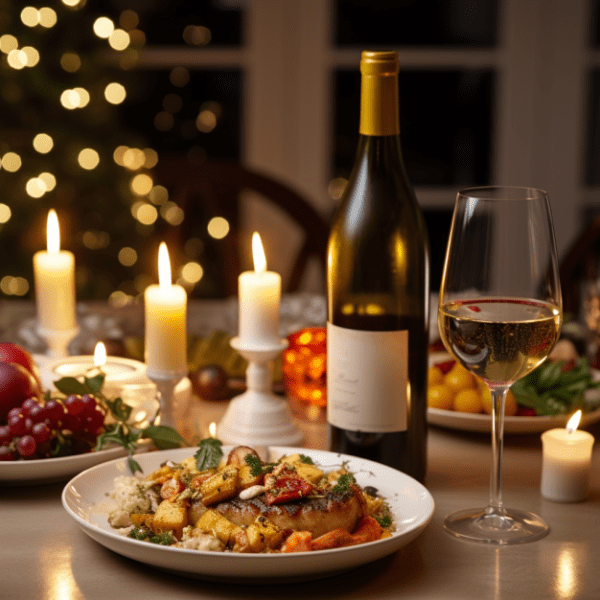
Food Pairings
Dry red wines are fantastic with food. Here are some pairing ideas.
Cabernet Sauvignon Food Pairings
Red Meats
This bold wine pairs wonderfully with red meats.
Try it with a grilled steak, roasted lamb, or beef stew.
The high tannins in Cabernet Sauvignon complement the fattiness of the meat.
Strong Cheeses
Pair it with strong cheeses like aged cheddar or gouda.
The bold flavors of the cheese match well with the intensity of the wine.
Hearty Vegetarian Dishes
For a vegetarian option, choose dishes like eggplant parmesan or mushroom risotto.
These hearty flavors and textures go well with the robust nature of Cabernet Sauvignon.
Merlot Food Pairings
Poultry and Pork
Merlot’s softer profile makes it a great match for chicken, turkey, and pork.
A roast chicken or pork tenderloin would be an excellent choice.
Medium-Strong Cheeses
Try Merlot with cheeses like brie, camembert, or mozzarella.
The wine’s fruitiness pairs nicely with these milder cheeses.
Pasta and Tomato-Based Dishes
Pasta with a tomato-based sauce, like spaghetti Bolognese, is a classic pairing with Merlot, as the acidity of the tomato sauce complements the wine’s flavors.
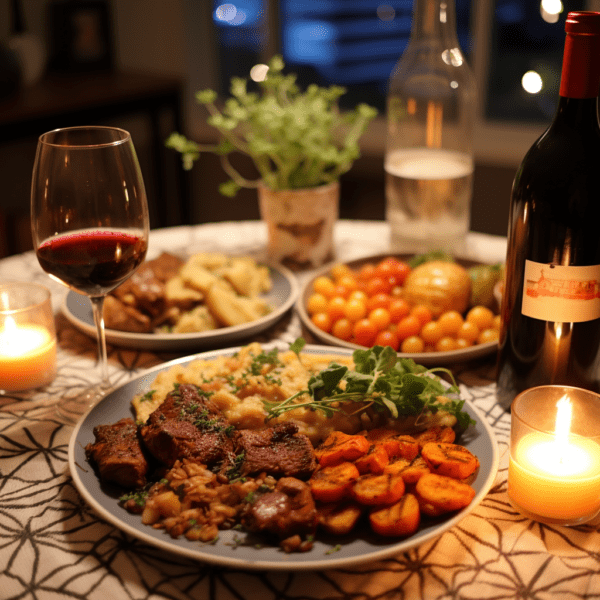
Pinot Noir Food Pairings
Light Meats and Fish
Pinot Noir goes well with lighter meats like chicken and duck, and even fish like salmon.
Its light body doesn’t overpower the flavors of these dishes.
Earthy Vegetables and Dishes
Try it with earthy dishes like mushroom risotto or roasted root vegetables.
The earthiness of the food highlights the subtle complexities of Pinot Noir.
Soft and Creamy Cheeses
Cheeses like goat cheese or feta can be a delightful pairing with Pinot Noir, as the creamy texture and mild flavors of the cheese complement the wine’s delicate profile.
Syrah/Shiraz Food Pairings
Spicy and Barbecued Foods
Syrah/Shiraz is excellent with spicy dishes or barbecued meats.
Think spicy ribs, grilled sausages, or even a spicy curry.
Strong Cheeses
Pair it with bold cheeses like Roquefort or sharp cheddar.
The intense flavors of these cheeses can stand up to the boldness of Syrah/Shiraz.
Hearty Stews and Braised Dishes
Hearty stews or braised meats, like beef stew or lamb shank, are great with Syrah/Shiraz.
The rich, meaty flavors of these dishes are complemented by the wine’s robust nature.
Remember, these are just guidelines.
The best part about wine and food pairing is experimenting and finding what combinations you enjoy the most.
Each palate is unique, so feel free to explore and discover your personal favorites!
Key Take-aways for Food Pairings:
Cabernet Sauvignon: Pairs well with red meats like steaks and robust cheeses.
Merlot: Great with poultry, pork, and medium-strong cheeses.
Pinot Noir: Complements dishes like salmon, chicken, and earthy vegetables.
Syrah/Shiraz: Ideal with spicy foods, barbecued meats, and strong cheeses.

Buying Tips for Dry Red Wines
Start with Approachable Varietals
If you’re new to wine tasting, begin with approachable and widely enjoyed varietals.
Merlot and Pinot Noir are great starting points as they are generally softer and more palatable for beginners.
As you become more accustomed to these, you can gradually move to bolder wines like Cabernet Sauvignon and Syrah.
Read the Label Carefully
The label on a wine bottle is your guide to understanding what’s inside.
Look for key information such as the grape variety, region, vintage (year of harvest), and alcohol content.
A higher alcohol content typically indicates a bolder, more intense wine.
Choose the Right Region
The taste of a wine can vary significantly based on where it’s from.
For instance, a Cabernet Sauvignon from Bordeaux, France, will taste different from one from Napa Valley, USA.
Research regions known for producing good quality wines of the type you’re interested in.
For beginners, wines from California, Australia, and Chile are often more fruit-forward and accessible.
Consider the Price Point
You don’t have to break the bank to enjoy good wine.
Many excellent dry red wines are available in the $15 to $30 range.
While there are exceptional wines at higher price points, as a beginner, it’s more practical to start with moderately priced bottles to understand your preferences.
Ask for Recommendations
Don’t hesitate to ask for advice when buying wine.
Staff at wine shops are usually knowledgeable and can recommend wines based on your taste preferences and the type of food you plan to pair it with.
If you’re dining out, a sommelier or waiter can suggest wines that will complement your meal.
Explore Online Wine Shops and Subscriptions
Online wine retailers and subscription services can be a great way to explore different wines.
Many of these services offer curated selections based on your taste preferences and provide detailed information about each wine, making it easier for beginners to learn and choose.
Attend Wine Tastings
Wine tastings are a fantastic way to explore different types of wines and learn what you like.
Many wine shops, wineries, and restaurants offer tastings, providing an opportunity to sample a variety of wines without committing to a full bottle.
Read Reviews and Wine Guides
Online reviews and wine guides can be helpful resources.
Websites like Wine Spectator, Decanter, and Vivino offer ratings and reviews that can guide your purchasing decisions.
Choosing and buying dry red wines can be an enjoyable experience, especially when you approach it with curiosity and an open mind.
Remember, the journey of exploring wines is highly personal.
Trust your palate and don’t be afraid to experiment.
Over time, you’ll develop a better understanding of your preferences and the vast world of wines.

Health and Dietary Information for Dry Red Wines
Sugar Content and Calories
Dry red wines are characterized by their low sugar content, as most of the sugar from grapes is converted into alcohol during fermentation.
This makes them a preferred choice for those monitoring their sugar intake.
Regarding calories, red wines generally contain around 125-130 calories per 5-ounce glass, but this can vary based on the alcohol content and specific wine type.
Higher alcohol wines tend to have more calories.
Antioxidants and Heart Health
Red wines, particularly dry reds, are rich in antioxidants like resveratrol, flavonoids, and tannins, which are believed to offer various health benefits.
Resveratrol, found in the skin of red grapes, has been linked to heart health, potentially reducing the risk of heart disease by lowering bad cholesterol and preventing blood vessel damage.
Moderate Consumption
While there are potential health benefits associated with red wine, it’s important to consume it in moderation.
The general recommendation for healthy adults is up to one glass per day for women and up to two glasses per day for men.
Excessive consumption can negate the benefits and lead to health risks.
Compatibility with Diets
Dry red wines are generally compatible with many diets.
They are low in sugar, making them suitable for low-carbohydrate and ketogenic diets.
For those following a gluten-free diet, most wines are naturally gluten-free.
However, individuals with specific dietary concerns or restrictions should always check for any additives or processing methods that might not align with their dietary needs.
Allergens and Sensitivities
While wine is typically free of common allergens, some people may have sensitivities to components in wine like sulfites, histamines, or tannins.
These can cause reactions in certain individuals, so it’s essential to be aware of any personal sensitivities.
Vegan and Vegetarian Considerations
Not all wines are vegan or vegetarian, as some winemaking processes involve animal-derived products like gelatin or egg whites for fining (clarifying the wine).
If you adhere to a strict vegan or vegetarian diet, look for wines labeled as such.
Enjoying dry red wine can be part of a healthy lifestyle when consumed in moderation.
Its low sugar content and presence of beneficial antioxidants make it a favorable choice for many.
However, it’s important to consider personal health conditions, dietary restrictions, and sensitivities when choosing and consuming wine.
As always, moderation is key, and if in doubt, consulting with a healthcare professional is advisable.
Dry red wines offer a fascinating range of flavors and experiences.
Whether you’re a seasoned wine enthusiast or new to the world of wines, exploring dry reds can be a delightful journey.
Remember, the best wine is the one that suits your taste, so don’t hesitate to experiment and find your favorite!
FAQ:
Q1: What exactly is a dry red wine?
A1: A dry red wine is a type of wine that has no residual sugar, meaning it isn’t sweet.
During the fermentation process, the yeast converts most of the sugar from the grapes into alcohol, resulting in a wine that tastes more crisp and less sweet.
Q2: Can dry red wines still have a fruity flavor?
A2: Yes, dry red wines can still have a fruity flavor.
The term ‘dry’ refers to the lack of sweetness, not the absence of fruit flavors.
Many dry red wines exhibit rich fruit flavors such as berries, cherries, and plums.
Q3: What are some popular types of dry red wine?
A3: Popular types of dry red wine include Cabernet Sauvignon, Merlot, Pinot Noir, and Syrah/Shiraz.
Each of these offers distinct flavors and characteristics.
Q4: How should I serve dry red wine?
A4: Dry red wines are best served at slightly below room temperature, around 60-65 degrees Fahrenheit (15-18 degrees Celsius).
This temperature helps to enhance the flavors and aromas of the wine.
Q5: Are dry red wines good for health?
A5: In moderation, dry red wines can be part of a healthy diet.
They contain antioxidants like resveratrol, which have been linked to heart health.
However, it’s important to drink responsibly, as excessive consumption can lead to health risks.
Q6: What foods pair well with dry red wines?
A6: Dry red wines pair well with a variety of foods.
Hearty meats like steak and lamb go well with bolder wines like Cabernet Sauvignon, while lighter meats like chicken and fish can be paired with softer wines like Pinot Noir.
Q7: How do I choose a good dry red wine if I’m a beginner?
A7: If you’re new to red wines, start with something approachable like a Merlot or Pinot Noir.
Look for wines from regions known for their quality and read the labels to understand the wine’s characteristics.
Don’t hesitate to ask for recommendations at wine shops or restaurants.
Q8: Can dry red wines be aged?
A8: Yes, many dry red wines can benefit from aging, which can enhance their flavors and complexity.
However, not all red wines are meant to be aged long-term.
Research or consult an expert if you’re interested in aging wines.
Q9: Are there any dry red wines that are vegan or vegetarian?
A9: Yes, there are vegan and vegetarian dry red wines available.
Some winemaking processes use animal products, so look for wines that specify they are vegan or vegetarian on the label.
Q10: How long can I keep an opened bottle of dry red wine?
A10: Once opened, a bottle of dry red wine typically lasts 3-5 days if properly re-corked and stored in a cool, dark place.
Some wines may begin to lose their character after a couple of days, so it’s best to consume them sooner rather than later.



